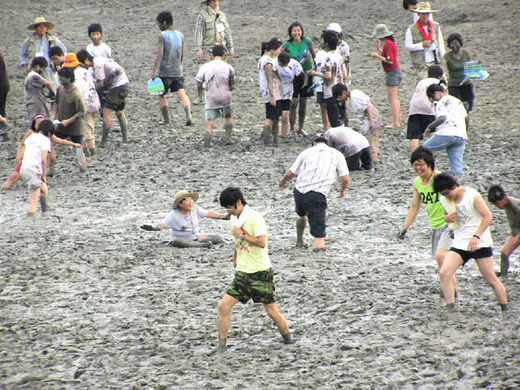 |
|
Festivalgoers walk on a tidal flat earlier this month.
|
School programs, festivals take their toll on delicate ecosystem
For biologists who carry out their research on muddy, rich tidal flats, the word "big" signifies any length over 1 millimeter. A creature with a length of 0.2 millimeter, which can be seen with the naked eye, is categorized as “mid-sized.” Crabs and clams that live in tidal flats are exceptionally large, compared to their fellow creatures. The tiny organisms living in tidal flats are understandably quite vulnerable to any small disturbance. But programs for "experiencing" the flats are gaining in popularity. Local governments are racing to lure visitors, as the five-day workweek, introduced in 2004, has freed up weekend time for many families. Civic organizations are joining the bandwagon by including tidal flats experience activities into their environmental education programs. Last year, about 46,000 people participated in 153 programs involving the tidal flats. However, the number of unofficial visitors to tidal flats nationwide may have reached about 1 million. One of the main activities during tidal flats programs is to hunt for creatures with hoes or rakes. However, such activities were found to have a worse-than-expected impact on the tidal flats.Between August and December last year, a research group within the National Fisheries Research and Development Institute conducted a survey of three tidal flats, located in Mohang in Buan County of North Jeolla Province, Seondo in Seocheon County of South Chungcheong Province, and Namgok in Boryeong County of South Chungcheong Province. The Mohang flats saw South Korea’s first "tidal flats Olympics" on August 6 of last year. The two-day event of soccer and Korean traditional wrestling games allowed full access to the flats, normally cordoned off as a nature preserve. One day after the event, however, the environmental survey group found that 14.8 percent of the flat’s "large" creatures and 12.5 percent of smaller fishworms were gone. Surprisingly, the negative impact continued to worsen in the month following the event, with inhabitant density of the large creatures falling to 51.1 percent. The research center’s Ko Byung-seol, who led the survey, called its findings "unexpected." He said that the creatures, when their habitats were trampled upon during the festivities, must have "died slowly." Humans stepping on tidal flats is more lethal for smaller creatures, which breathe via minute holes in the tidal flats. At the same site, the density of fishworms fell to 60 percent the next month, worsening to a 36.4 percent density two months later. At the site, it took three months for the "large" creatures to recover to 80 percent of their original levels. For levels of slow-moving creatures in tidal flats to recover, larvae migrating in from ocean waves must first grow to maturity. One tract of tidal flats at Seondo is open to visitors year round. The research team conducted a survey on how 35 elementary school students affected the site after a 30-minute program. During the program, the student caught an average of 7.5 creatures each, representing 32 grams of sea life per student. The damage rate was found to be 45 percent when students were allowed to hunt, compared with a rate of 20 percent when they were only allowed to observe. In another section of tidal flats at Namgok, where large-scale experience programs and other events are held frequently, the inhabitant density had fallen to 56 percent as of December last year and has not yet recovered. "If a disturbance is made when creatures are laying eggs or larvae are adapting to the flats, it will deal a lethal blow," Ko said. "[Local governments] should adjust their dates for allowing people to enter the tidal flats to be in line with the life cycles of creatures there." Baek Yong-hae, head of the Korea Tidal Flats Research Center, said, "Because small creatures in tidal flats have no protective organs, stepping on tidal flats is the deadliest threat to them. We have to change our sense of awareness," he said, of tidal flats as "a playground."





